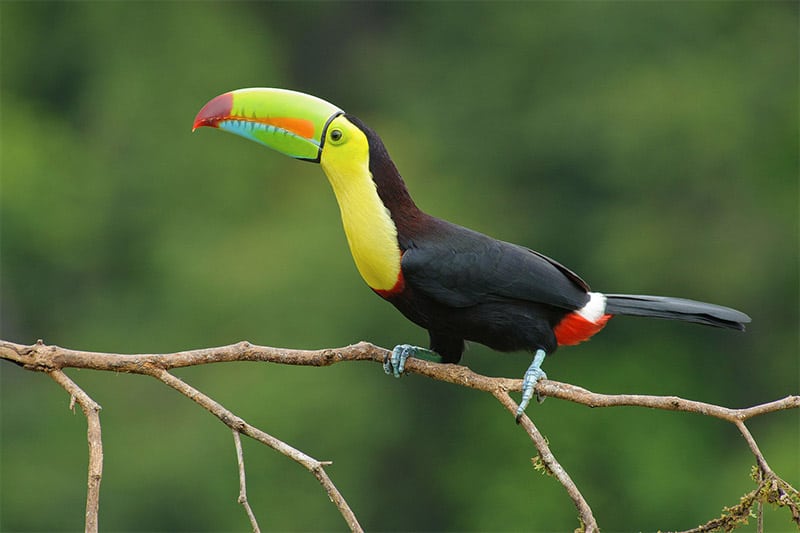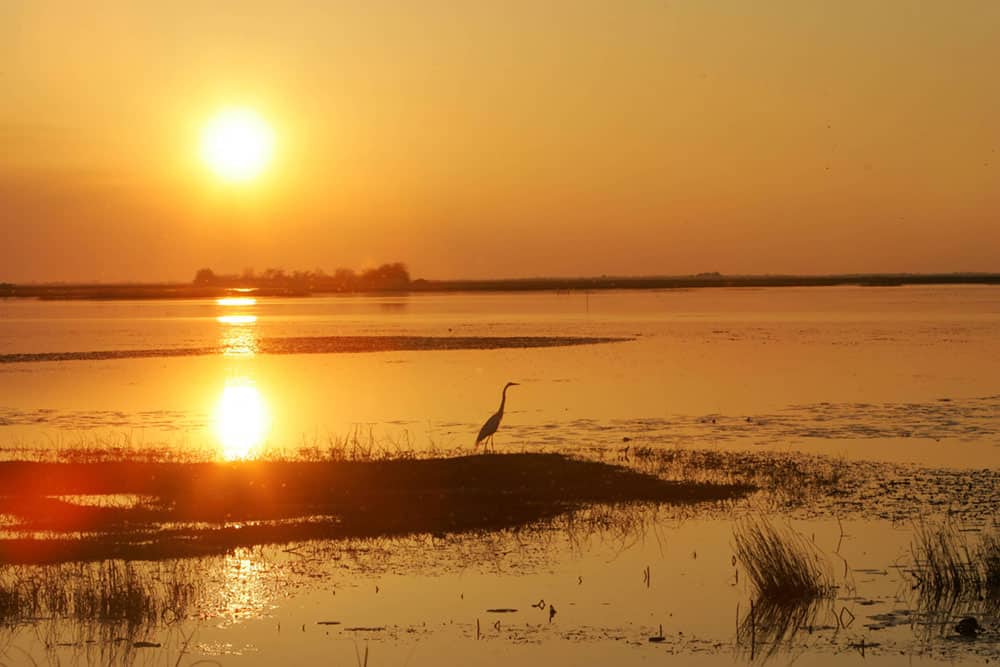The Travel Mindset
Tikal, Guatemala: Travel in the late 1980s was a different experience than the beaten path that exists now. Jolting along the potholed road in the aeropuerto bus, we made a stop in the middle of nowhere and let a few Dutch girls off the bus. We wondered where we were, and where the heck those young women were headed—and whether we were supposed to get off at this stop too. Then we noticed a small, battered roadside sign: Gringo Perdido. Lost Gringo. Yep, that about summed it up—for both the Dutch girls and, in the early days of our journeys, my husband and me.
After decades of globetrotting, we now feel a little less perdido as we travel. But, truthfully, that feeling is one of the thrills of travel when it’s kept at a manageable level. This article’s purpose is to help you feel a little less lost in your birding travels and to help you achieve that manageable level.
Previously I’ve written about packing and planning (“Pack Light, Bird More” in May/June 2007 and “Plan Right, Bird More” in January/February 2009). Now that you’ve planned your trip and packed for the journey, it’s time to dispel some of the worries involved in the actual process of traveling.
When you’re in the thick of it—stepping off that plane and being hit with the sights and smells and strangeness of it all—that’s when you want to grin and step forth and take it all in, rather than cringing with the panicked thoughts: “Oh no! Where can I exchange money? Is this food safe for me? What the heck is the word for bathroom?”
So, first, strive for “The Travel Mindset.” Know that you’ll feel unseated, that the unexpected will arise, and that you’ll have to be flexible. Know that people are people everywhere; know that you’ll come away from every situation stronger and wiser; and know that you need to be militant in your optimism and in your wide-eyed soaking-in of our world.
Let’s tackle the brass tacks stuff in the chronological way that the situations usually arise. The emphasis in this article is on international travel, but you can apply the same good preparation, skills, and common sense required for Guatemala, Ecuador, or Uganda to—say—Nebraska, Texas, or Oregon.
Arrival
Costa Rica: Our plane was late leaving Miami, and it was a bleary-eyed 1 a.m. by the time we arrived in San Jose. To make matters worse, the customs wait was excruciatingly long; we nearly fell asleep standing in line. Finally, we made it to the official’s booth, only to be told that we didn’t have the necessary tourist card and must get in that other line over there.
Make sure you thoroughly check out the passport and visa procedures before you arrive. Some countries require just your passport, some require a paid visa acquired weeks ahead of time, some issue a free visa or tourist card on the plane, and some have an airport desk you must visit before the passport and customs lines.
Double-check that your passport is not going to expire within a few months and that there are empty pages left. Officials whomp their stamps all over the place, using a clean page each time.
Also, arrive with some local currency in hand. Your hometown bank may offer preordered foreign currency at a nominal charge and a decent exchange rate, or visit the currency exchange booth in your U.S. gateway airport.
Don’t rely on visiting a bank for your first new-country activity. You may arrive late at night when banks won’t be open, and even if you arrive during the day, you may be befuddled, excited, and tired. The last thing you’ll want to do is have to find a bank (without proper cab fare) and stand in (another) line.
And as long as we’re talking money—stock yourself with some of every kind: two types of credit cards (Visa, MasterCard, or American Express), traveler’s checks, and cash (both U.S. and local currency). Accepted forms of payment vary from country to country and place to place, so you never really know what type you’ll need.
On the Road
Thailand: Driving a rental car from Bangkok to Chiang Mai is not something tourists generally do, as we found out later. The roads are chockablock with traffic—trucks, buses, cars, motorbikes, tuk-tuks, bicycles, and pedestrians—all completely ignoring any kind of lane structure. We remembered the rule we learned driving in Mexico, Venezuela, and Spain: The biggest thing on the road has the right-of-way. Period.
Food Safety
Ecuador: At a lovely upscale hacienda near Cotopaxi National Park, I ordered a chicken-rice dish, seemingly safe. But chopped clams were hidden among the veggies, and while my husband spent the next day in the shadow of the volcano with the llamas and birds of the high Andes, I was back in the room, weak and spent from a night in the bathroom.
The lesson here is that high-class tourist hotels can be as risky as street-vendor food. If you’re uncertain about food safety in the area you’re visiting, stick to bottled water, avoid ice in drinks, and choose cooked and hot food only—no salads, pre-cut fruit plates, or shellfish.
Insect Safety
South Africa: We returned to our safari lodge at dusk after an amazing day of watching elephants, cheetahs, hyenas, and other wildlife. This is the time of day when one should follow all the malaria precautions, but we wondered if the long sleeves, DEET, and prophylaxis pills were overkill when witnessing the South African families in shorts and tank tops.
The next day, we read in the newspaper that a Durban doctor had died of malaria. Then we knew—nope, it’s not overkill. Don’t necessarily follow the locals’ example. Know and decide for yourself what precautions to take.
The Bird Watching
But wait! Travel isn’t all about cautions and risks and hazards. I want to make it clear that the birds, the sights, and the sheer experience of it all far outweigh these manageable concerns. With the right information (which the Internet has revolutionized) and a little travel savvy, you can venture out boldly and happily. All these potholes and bumps that I’ve mentioned so far were smoothed into experiences remembered with a deep glow. For example:
That jungle bus continued on and brought us safely to Tikal, where we spent happy days watching toucan flocks and howler monkey troops from the temple tops. Good birds seen: ocellated turkey, keel-billed toucan, blue-crowned motmot.
Once through those Costa Rican entry requirements, we headed up to then-undeveloped Monteverde for our first real cloud forest adventure. Good birds seen: resplendent quetzal, violet sabrewing, barred forest-falcon.
That hard driving in Thailand brought us to a lovely lake afloat with lotus which only opened with the first sun of the morning. Good birds seen: pheasant-tailed jaçana, spot-billed pelican, white-crested laughing-thrush.
The Ecuadorian Andes, at Pappallacta Pass, gave us our first view of the Andean condor and of the green Amazon basin beyond. Good birds seen: rufous-bellied seedsnipe, Ecuadorian hillstar, Andean gull.
At our cabin in Kruger National Park, monkeys cavorted on the roof, baboons raided our fridge, and a black-maned lion roared at night just across the river. Good birds seen: hammerkop, maribou stork, secretary bird.
Beyond the Bird Watching
When you pull over next to that roadside wetland or patch of wood, curious locals will often wander over and wonder what you’re doing. This is a good opportunity to show them your bird book, practice the word bird (ave/oiseau/passaro) that you’ve learned in their language, and generally spread the concept that their wildlife and undisturbed habitat have real value. It’s also an opportunity to obtain local knowledge you might otherwise never obtain.
Beyond this type of contact, birding can open the door to more lasting friendships. Ramiro Yabar, our bird guide from Cusco, Peru, has since become a good friend. We have returned to travel with him—from the Andes to the Amazon—time and again. And this also spurred his first trip here, to the United States.
When traveling with a guide or group, don’t forget the nightly bird list. After a day of ogling antbirds or babblers or bee-eaters, meet your travel partners for a well-deserved dinner, cold drink, and story-swap. Afterward, go over the checklist. It’s more than a recording of species; doing this nightly cements the experience and the camaraderie.
Of course, we’ve just scratched the surface of travel here, opened only the first chapter of that how-to book, but enough, I hope, to spur enthusiasm and a desire to run to the airport.
Charles Darwin said of travel, in his 1845 Voyage of the Beagle, “The map of the world ceases to be a blank; it becomes a picture full of the most varied and animated figures.” One could extrapolate that into bird terms: “The checklist at the back of the book ceases to be a blank; it becomes a mental picture full.”
But it’s not all about listing, of course. Travel has benefits far beyond merely making tick marks and collecting bragging rights. And the benefits ripple both inward, for the traveler, and outward, for the country visited. So get out there. The butterfly effect definitely applies here, and the world will be a better place if you do.




